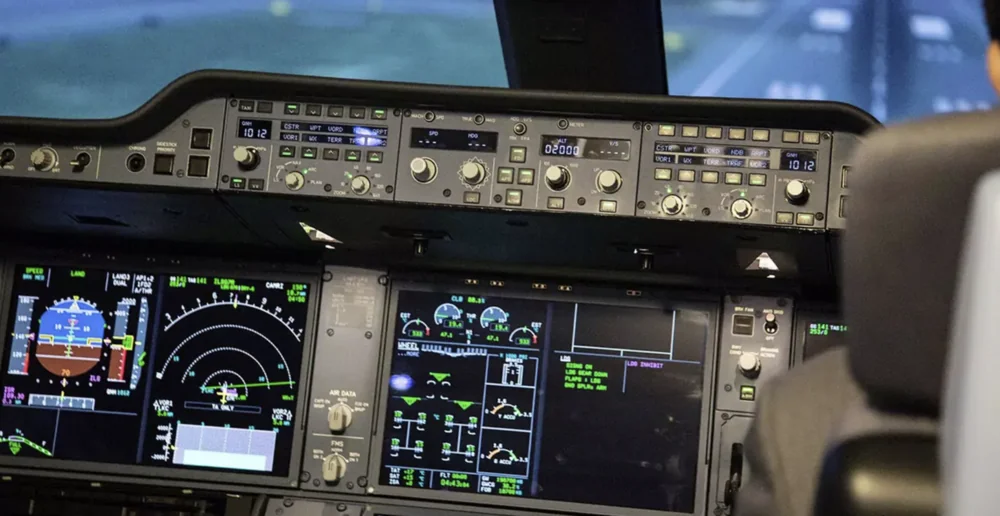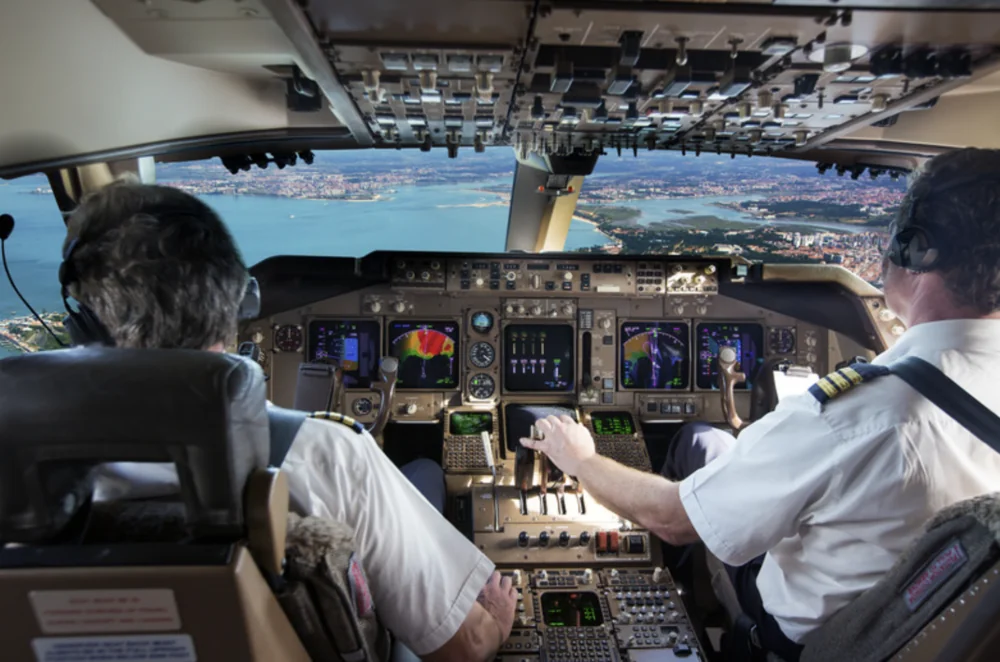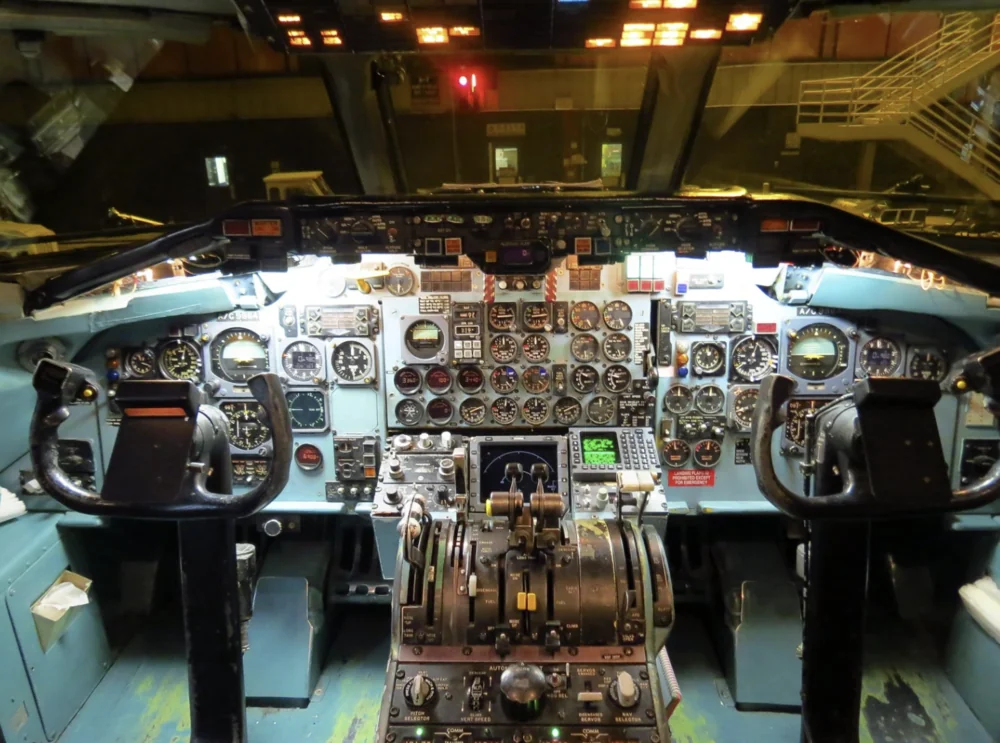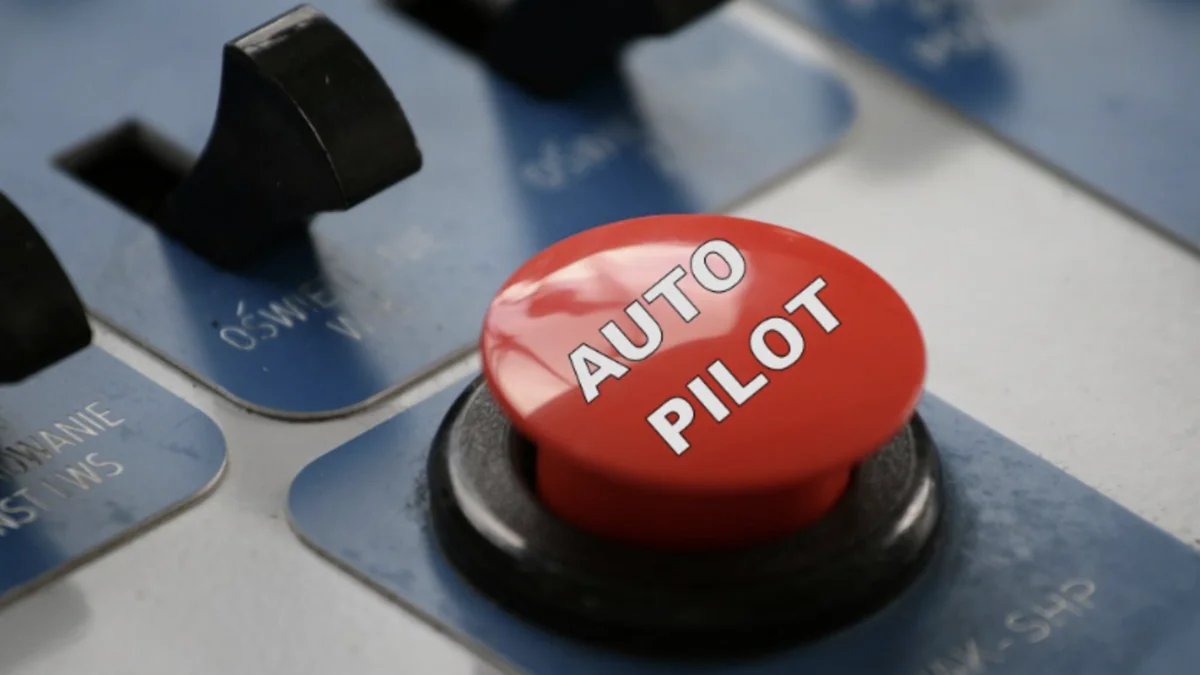Autopilot has become a common feature. It’s impossible to imagine modern aircraft without it. Today, let’s talk about its origins and how it works.

The development of flight assistance systems, now widely known as automatic piloting or simply autopilot, has played a crucial role in aviation, allowing pilots to focus on other aspects of flight. In the early years of aviation, there were no advanced navigation or control systems, and pilots had to rely solely on their experience and instincts. Today, autopilot systems take over many of the pilot’s tasks, but it wasn’t always this way.
Read also:
- Little-Known Pages of Aviation History: Northrop XP-79B “Flying Ram” – The Ramming Attack Aircraft
- All About the Rogue 1 Loitering Munition by Teledyne
TABLE OF CONTENT:
At the beginning of the aviation era
The first attempts to create autopilots date back to the time before World War I when stabilizing gyroscopes began to be used. These early efforts, which can be considered the predecessors of modern autopilots, aimed to assist pilots in maintaining a steady course and position of the aircraft. One of the pioneers in this field was the American inventor Elmer Ambrose Sperry, who developed the first pilot assistance system to maintain a constant course in 1912.
Sperry’s system used gyroscopes to help keep the aircraft in the desired position. Sperry’s “autopilots” were already being used in military aviation during World War I, contributing to the popularization of the idea. At that time, airplanes could not fly in bad weather or darkness, as it could lead to pilot disorientation.

Lawrence Sperry, the son of Elmer Sperry, publicly demonstrated his father’s invention in 1914 at an aviation safety competition in Paris. Sperry Jr. showcased the reliability of the invention by flying the aircraft with his hands visible and away from the controls, allowing the gathered audience to see it in action. His demonstration and the invention itself caused quite a sensation and sparked considerable interest. Although it couldn’t yet be called an autopilot, it was seen more as the “tricks” of a clever aviator and inventor, as the press of the time suggested. However, the foundation was laid.
Yes, in 1930, the Royal Aircraft Establishment in the UK developed an autopilot that used a pneumatic gyroscope to control the aircraft’s control surfaces. The autopilot continued to evolve, and the addition of new tools, such as radio navigation devices, made it possible to fly at night and in poor weather conditions. It was not until 1947 that a C-53 transport aircraft of the US Air Force made the first transatlantic flight, including takeoff and landing, entirely under autopilot control. The aviation community was thrilled, and science fiction writers began predicting an era of autopiloted airplanes and helicopters for humanity.
What is autopilot
An autopilot is software or a tool that can control an aircraft under certain conditions, using the aircraft’s hydraulic, mechanical, and electronic systems. This system, which can follow a flight plan, can stabilize speed and altitude, as well as the orientation of the aircraft’s nose (direction).

Pilots mostly control the aircraft using autopilot, except during takeoff and landing. Autopilot is primarily used on passenger airplanes.
How the autopilot works
Let’s delve into the principles of autopilot operation in more detail. As aircraft evolved and flight complexity increased, there was a need to automate navigation and stabilize flight in poor weather conditions, at dusk, and at night. In response to these needs, autopilots began to be equipped with automatic control systems and systems that allowed for flight programming and tracking using navigation data.
The implementation of autopilot systems on passenger aircraft required meeting certain aviation regulations. Regulatory organizations, such as the European Union Aviation Safety Agency (EASA) and the United States Federal Aviation Administration (FAA), developed guidelines and standards that specify the tests and certifications autopilots must undergo to ensure the safety of passenger flights.

Overall, the principle of autopilot operation, regardless of its application, is based on three elements: measurement, comparison, and control.
The first step in autopilot operation is analyzing the current state of the vehicle and its environment. This is achieved using various sensors such as gyroscopes, accelerometers, magnetometers, speed sensors, altitude sensors, radars, vision systems, and satellite navigation. All of these sources provide information about the aircraft’s status, including its speed, altitude, direction, roll, position, and other parameters necessary for controlling the aircraft.
Then, based on the collected data, the autopilot compares the current values with target values or previously defined flight parameters. In modern passenger aviation systems, the pilot inputs pre-saved flight parameters into the computer before takeoff. At each stage of the flight, the route and specified parameters, including speed and altitude, are continuously compared with the sensor readings.
This comparison allows the autopilot to determine what adjustments are needed to maintain or alter certain flight conditions. For example, if the autopilot is set to maintain a constant altitude and the altitude sensor detects a decrease, the autopilot will take measures to increase thrust or adjust the angle of attack to compensate for the altitude drop, which might result from unexpected weather changes.
The final stage is control. The autopilot sends signals to the aircraft’s control systems, such as the control surfaces and engines. Based on the calculated adjustments, the autopilot generates control signals that influence the aircraft’s movement and keep it in the desired flight state.
Read also:
- Best Ukrainian Military UAVs, Part 1: Reconnaissance and Targeting
- Boeing and Antonov to Collaborate on Defense Projects
How does the autopilot work?
The autopilot can be involved in most control mechanisms, except for takeoff. Generally, it manages the aircraft’s movement relative to its center of gravity and guides the aircraft according to safety parameters. The flight data prepared before takeoff is loaded into this software. Once the autopilot receives instructions from the pilot, it controls the aircraft within the specified route.

Modern aircraft can have three different types of autopilot software: single-axis, dual-axis, and three-axis. Clearly, next-generation aircraft will be equipped with advanced three-axis autopilots. This type of next-generation autopilot can also control the aircraft’s yaw, managing the rudder along with roll and pitch movements. In new systems, the autopilot can perform most classic flight maneuvers. Altitude adjustments and descent are managed by pilots, except in extreme cases. However, the autopilot still performs all operations strictly according to the pilot’s commands.
Auxiliary controls
One interesting example of autopilot implementation is the CWS (Control Wheel Steering) system, which can be literally translated into Ukrainian as “рульове керування кермом.” This term is used to describe one of two significantly different modes or functions of the autopilot. The distinction depends on the type of autopilot and the aircraft manufacturer.
In one application, the CWS button, located on the control panel and often referred to as the Touch Control Steering (TCS) in many aircraft, temporarily disengages the autopilot servos while the aircraft is manually maneuvered. On the other hand, CWS is a selectable autopilot mode that allows changes to the aircraft’s pitch and roll by manipulating the control yoke instead of using pitch or roll selectors on the autopilot control panel. In the latter scenario, the aircraft’s response to control yoke movements in CWS mode is somewhat similar to the response of a Fly-by-Wire system.

With the CWS system, the pilot makes control yoke movements, which are interpreted by the autopilot system. The autopilot analyzes data from sensors such as gyroscopes, accelerometers, and position sensors, and compares this data with the flight parameters programmed into the software. Based on this information, the autopilot takes appropriate actions and sends signals to the aircraft’s control systems.
The CWS system offers several advantages. Firstly, it allows the pilot to have more control over the aircraft compared to full automation. The pilot can actively participate in the control process by making yoke movements and selecting the aircraft’s direction and roll. The CWS system adapts to these movements, minimizing the need for the pilot to make additional corrections.
Secondly, the CWS system can also serve as a pilot training tool. It allows pilots to gain experience in manual aircraft control while benefiting from the support and safety provided by the autopilot. This intermediate solution enables pilots to gradually develop manual control skills while still taking advantage of the advanced features of the autopilot.
How to use the autopilot and where is it located?
The modern autopilot is integrated into the flight management system, which is part of the aircraft’s avionics. Control elements are located in the cockpit, typically on the instrument panel or central console.
This system is akin to a computer that coordinates information from various sources about the aircraft’s position, calculates the current location as accurately as possible, and manages the flight path according to the parameters programmed by the pilot.

To manage the system, it is connected to a Multi-Function Control and Display Unit (MCDU), which consists of a keyboard and screen for visualizing various parameters and controlling the device. Additionally, it has its own control panel where parameters such as course, speed, and altitude are monitored.
In addition to these electronic devices, aircraft are still equipped with conventional sensors, mechanisms, and actuators. However, the autopilot makes the flight safer and more efficient.
Should you trust the autopilot?
Modern aircraft autopilots rely on advanced computer systems that play a crucial role in managing the aircraft. The autopilot software is responsible for analyzing data, making decisions, and issuing the appropriate control commands. Due to the immense risks associated with a machine traveling at an altitude of 11 km, one of the most critical protection systems for modern aircraft control computers is redundancy – duplicating the same resources two or three times.
In practice, this means that critical software processes are not only executed on separate computers and possibly even using different architectures but also on each computer with software developed by different engineering teams, often programmed in different programming languages. This is because separate teams of engineers and developers are unlikely to make the same errors. If one computer fails, another can take over its tasks. However, due to the rising costs of software, these safety measures are increasingly being abandoned.

An aircraft must have a backup system in case the autopilot fails. The pilot should always be ready to take control of the aircraft if necessary. The safest combination for flight is a pilot who understands both the capabilities and limitations of the installed autopilot system.
The autopilot has a high capability to detect abnormal operations and analyze conditions and necessary decisions. By making the required adjustments, the autopilot can reduce human errors and ensure flight safety. Accordingly, at any moment, the pilot is able to disengage the autopilot system and take manual control of the aircraft.
While the autopilot enables the aircraft to perform automated flight, it requires human/pilot oversight for safety and optimal flight performance. This means the role of the autopilot in the aircraft is to serve as a tool to assist in managing the pilot’s workload. The combination of the pilot and autopilot creates the most effective conditions for safe flight.
Read also:








